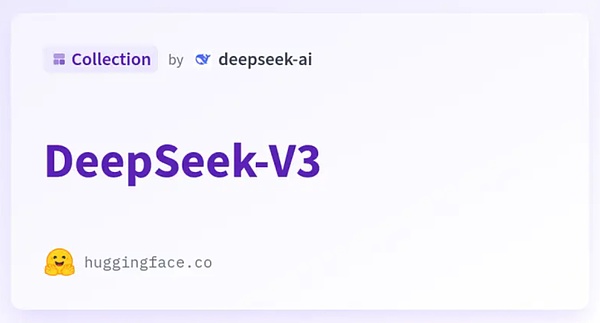
Translated by: Heart of the Metaverse
Recently, the rise of DeepSeek has sparked extensive discussions among venture capitalists and entrepreneurs in Silicon Valley. As an emerging force in the field of artificial intelligence, the rapid development of DeepSeek has made people begin to rethink the future of AI innovation, the dominance of open source models, and the sustainability of traditional AI business models.
The core of this discussion is: Does DeepSeek represent a paradigm shift, or is it just a brief shock? How should existing AI companies deal with this change?
01.DeepSeek's Innovation and AdvantagesDeepSeek quickly emerged in the AI developer community, topped the Hugging Face rankings, and became the dominant force in the open source field.
Its design philosophy with speed, cost-effectiveness and accessibility as its core has won wide praise from the global AI research community. Unlike competitors, DeepSeek operates at extremely low costs, providing top-notch AI capabilities without relying on massive infrastructure.
While media speculates that the power landscape in the AI field is changing, the reality is more complicated: DeepSeek's innovation is prompting existing players to rethink their strategies and push the industry toward a more streamlined and more efficient AI model transformation.
DeepSeek's success stems from its focus on efficiency and technological creativity. The company excels in code generation and natural language processing with its DeepSeek Coder and DeepSeek-V3 models.
DeepSeek uses reinforcement learning without human intervention, distinguishing itself from AI companies that rely on human feedback (RLHF) learning.
Its R1-Zero model is learned entirely through an automated reward system and is able to self-rated in math, programming, and logic tasks. This process has spawned spontaneous “think chain reasoning” capabilities, enabling models to extend inference time, reevaluate hypotheses and dynamically adjust strategies.
Although the initial output was mixed with multiple languages, DeepSeek successfully developed the DeepSeek R1 model by introducing a small amount of high-quality manual annotation data in the RL process.
In addition, DeepSeek also adopts a "expert hybrid" (MoE) design. MoE technology allows the model to dynamically select specialized subnetworks (i.e. "experts") to process different parts of the input, thereby significantly improving efficiency.
Unlike traditional holistic models, MoE only needs to activate a portion of the expert network, thereby reducing computing costs while maintaining high performance. This approach enables DeepSeek to scale efficiently in low power consumption and low latencyProvides better accuracy in the case.
DeepSeek focuses on RL, MOE and post-training optimization, demonstrating the future of AI computing infrastructure with optimized memory, network and computing, more granular, faster and smarter.
02. Challenge the traditional proprietary model Ashu Garg, general partner of Foundation Capital, predicts that scale is no longer the only winning weapon in the AI field. He pointed out that DeepSeek regards AI as a system challenge, and has been fully optimized from model architecture to hardware utilization.He also stressed that the next wave of AI innovation will be led by startups that use big models to design complex "agent systems" that can handle complex tasks rather than just automate simple operations.
Without Nvidia's top-level H100 GPU, DeepSeek enhances inter-chip communication by reprogramming 20 processing units on the H800 GPU and leverages FP8 quantization technology to reduce memory overhead. In addition, they have introduced multi-token prediction technology, which enables the model to generate multiple words at once, rather than word-by-word generation.
More than that, DeepSeek's success in the field of open source AI challenges traditional proprietary model models. The widespread adoption of its framework shows that AI development is shifting towards a more community-driven direction.
DeepSeek also broke the inherent concept that "large-scale AI breakthrough requires huge infrastructure investment." By proving that top models can be trained efficiently, it forces industry leaders to rethink whether it really requires billions of dollars in GPU clusters.
As AI models become more efficient, the overall usage is also increasing.
DeepSeek's cost-effectiveness lowers the barrier to entry, giving birth to a group of emerging startups that adopt streamlined AI architectures. This trend suggests that the AI ecosystem is undergoing a broader shift, and efficiency is becoming a core differentiator, not just raw computing power.
In fact, DeepSeek did not create a new field, but optimized and improved existing AI technologies and demonstrated iterations. The power of
This raises the question: Is first-mover advantage really sustainable in AI development? Perhaps, continuous improvement is where real leadership lies.
With advances in speed, reasoning capabilities and cost-effectiveness, DeepSeek is paving the way for a new era of AI-driven applications.
The industry is about to usher in a wave of AI agents that can handle complex workflows that will revolutionize industries by increasing efficiency, reducing costs, and achieving new use cases that have not been possible in the past.
In general, the rise of DeepSeek marks the AI solutions towards being more accessible and more compatibleCost-effective development.
As the industry adapts, companies must find a balance between proprietary innovation and open cooperation to ensure that the next wave of AI development remains efficient, adaptable and scalable. With the continuous advancement of AI technology, the interaction between leading AI companies and emerging players will define the next stage of technological progress.











